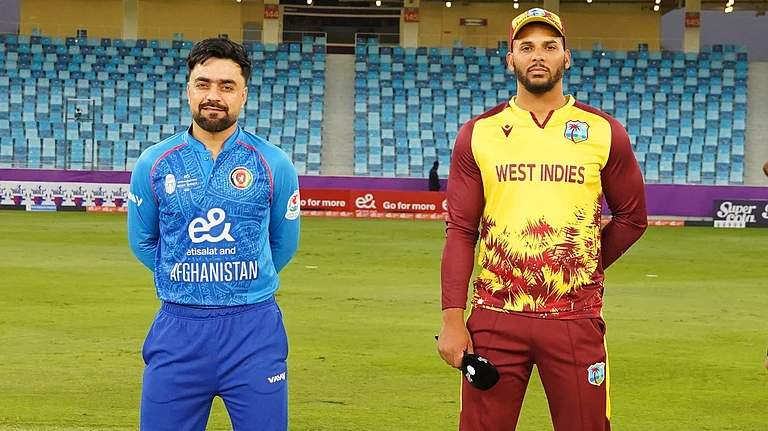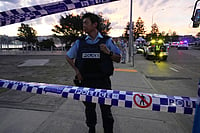A 34-year-old man from Delhi with no history of foreign travel tested positive for monkeypox, taking India's tally of cases to four and prompting the Centre to hold a high-level review meeting, the government said on Sunday.
Three cases of monkeypox were earlier reported from Kerala. The Delhi patient, who is recovering at a designated isolation centre at the Lok Nayak Jai Prakash (LNJP) Hospital in the national capital, had attended a stag party in Manali in Himachal Pradesh recently, official sources told PTI.
According to them, so far nine contacts, including family members of the patients, have been quarantined and they are being followed up. They are asymptomatic as of now.
The west Delhi resident was isolated at the LNJP hospital three days ago after he showed symptoms of the disease. Union Health Ministry officials said his samples were sent to the National Institute of Virology (NIV) Pune on Saturday which came out positive.
"The person is recovering at the designated isolation centre at the LNJP hospital. The close contacts of the case have been identified and are under quarantine following health ministry guidelines," the ministry said.
"Public health interventions like identification of the source of infection, enhanced contact tracing, testing, and sensitisation of private practitioners are being carried out. A high-level review of the situation has been planned by the Directorate General of Health Sciences on Sunday at 3 pm," it stated.
The World Health Organisation (WHO) on Saturday declared monkeypox a global public health emergency of international concern. Globally, over 16,000 cases of monkeypox have been reported from 75 countries and there have been five deaths so far.
In the WHO South-East Asia Region, besides India, one case has been detected in Thailand. Director General of Health Services (DGHS) Atul Goel on Sunday reviewed the monkeypox situation in the country and directed the National Centre for Disease Control to carry out a detailed epidemiological investigation of the cases.
In the meeting, the need for a targeted approach towards high-risk groups such as men who have sex with men by the National AIDS Control Organisation (NACO) was highlighted.
As NACO is the nodal agency which works towards preventing the spread of HIV and control of sexually transmitted diseases and reproductive tract infections, it was asked to frame guidelines for high-risk groups of monkeypox, an official source said.
It was stressed that health facilities should keep a lookout for people who complain of an unexplained rash and have travelled in the last 21 days to a country that has recently had confirmed or suspected cases of monkeypox.
The Health Ministry had last week reviewed the screening procedure of international travellers arriving in India after cases of the virus were reported in the country.
Airport and Port Health Officers and directors of regional offices of the health and family welfare ministry were advised to ensure strict screening of all international travellers to minimise the risk of monkeypox cases in the country.
According to WHO, monkeypox is a viral zoonosis – a virus transmitted to humans from animals – with symptoms similar to smallpox although clinically less severe.
It typically manifests itself with fever, rash and swollen lymph nodes and may lead to a range of medical complications. It is usually a self-limited disease with symptoms lasting for two to four weeks.
The 'Guidelines on Management of Monkeypox Disease' issued by the Centre stated that human-to-human transmission occurs primarily through large respiratory droplets generally requiring prolonged close contact.
It can also be transmitted through direct contact with body fluids or lesions, and indirect contact with lesion material such as through contaminated clothing or linen of an infected person. Animal-to-human transmission may occur by bite or scratch of infected animals or through bush meat preparation.
The incubation period is usually from six to 13 days and the case fatality rate of monkeypox has historically ranged up to 11 per cent in the general population and higher among children. In recent times, the case fatality rate has been around three to six per cent.
The symptoms include lesions which usually begin within one to three days from the onset of fever, lasting for around two to four weeks and are often described as painful until the healing phase when they become itchy. A notable predilection for palm and soles is characteristic of monkeypox, the guidelines stated.
Experts, however, said there is no need to panic as it is less contagious and rarely fatal. A monkeypox outbreak can be tackled by strong surveillance. The virus spread can be contained by isolation of confirmed cases and quarantine of contacts, they said and underlined that immunocompromised individuals need to be taken care of.
Senior scientist at NIV Dr Pragya Yadav said the monkeypox virus is an enveloped double-stranded DNA virus having two distinct genetic clades -- the central African (Congo Basin) clade and the west African clade.
"The recent outbreak which has affected several countries leading to a worrisome situation is caused by the West African strain which is less severe than the Congo lineage reported earlier. The cases reported in India are also of the less severe West African lineage," she told PTI.
(With PTI inputs)


























